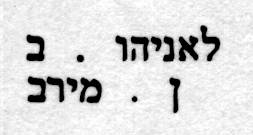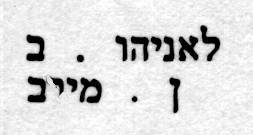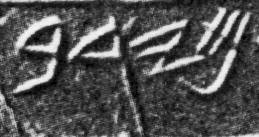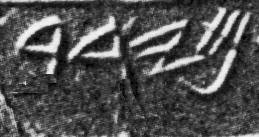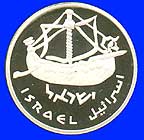Origins of Family Name Discovered in Middle-East
(quasi history by Bernie Mayoff)
Family name traced back to King Saul
Pictured is an ancient Hebrew seal bearing an inscription and a drawing of a ship. The inscription may be the among the oldest written examples of the name which evolved to become Mayoff. The seal is owned by an anonymous American and an impression of the seal was shared with Nahman Avigad of The Hebrew University of Jerusalem. The original analysis was documented in the Bulletin of the American Schools of Oriental Research, Number 246, Spring 1982. Not being a Mayoff, Avigad’s analysis missed the obvious and fanciful implications of what he observed on this seal.
The script on the seal is the semi-cursive formal Hebrew of the 8th-7th century B.C. This is an older form of Hebrew than the block Hebrew that we are familiar with, but anyone familiar with the older writing can easily translate the inscription. The inscription is divided into two lines and dots separate the words. (Could the dots be a forerunner to the modern internet? Was a Mayoff the real inventor of the internet?)
Using modern Hebrew, the inscription would be written as:
Now comes the interesting part if you’re a Mayoff, or a friend of a Mayoff, or a Mayoff wanna-be, or a potential Mayoff. The first word is translated as Belonging to Oniyahu. Then we have the dot (did you think I was kidding about inventing the internet?) The Hebrew word “ben” means “son of”. That word begins on the first line of the seal and flows over to the second line of the seal, followed by another dot. And now for the really important part. The last word on this seal is transliterated as Mayrob or Mayrov.
I hope we have your attention by now, because here is where we begin to see the actual formation of the name Mayoff. Go back and look closely at the modern Hebrew word Mayrov. Since Hebrew is written without vowels you see four letters. Reading from right to left the letters are M, Y, R, V (or B, V and B are sometimes interchangeable). Do you see what happened with time as you look at the Hebrew inscription.
Here is an example of what it would look like with some erosion or wearing away of just the last word:
Lo and behold, it has become M, Y, Y, V!!!! The oldest known written example of the name Mayoff!
Aha, you say, but this is an erosion of modern Hebrew. What about the ancient Hebrew? Here is an enlargement of the ancient form of the name:
Once again, reading from right to left, we easily see the four letters M, Y, R, V. Remember, this extremely well preserved seal dates back to 800-700 BC. Here is what something stamped with the last name part of the seal might look like after it experienced some wear:
It now looks like the letters M, Y, V, V!!!!!!!!!!!!! Can there be any doubt that this ancient seal is an indicator of the family name Mayoff?
Now that we have determined that this seal does, indeed, represent an early variant of the Mayoff name, let’s see what Avigad can tell us about the derivation. The first name on the seal, Oniyahu, also appears in a Hebrew tomb from the 8th century BC found at Khirbet el-Qôm in the Hebron hills. The name derives from the word for strength, and probably means “God is my strength”.
The name MYRV is of unknown etymology, but is a variant of the name MRV which of course could be pronounced the same way. That name, מרב = MRV, Merav or Merab, is the name of the eldest daughter of King Saul according to I Samuel 14:49 [see footnote 1]. This seal clearly says: “Belongs to Oniyahu son of Merav”, or “Of Oniyahu son of Merav”. Usually Hebrew seals and names derive along patriarchal lines, but there are examples in the Bible of people listed in terms of their mother’s names. If the name on the seal is a matronymic, it would be the first known occurrence of it on a Hebrew or related seal. It looks like Mayoffs may not only have invented the internet — Mayoffs may have been the first to recognize women’s rights and women’s equality on legal documents!
I know you’re wondering about the ship. This is the first realistic representation of a ship found on a Hebrew seal, and it is dateable to the First Temple period. It cannot be determined if the seal owner, Onihayu, was a mariner or connected with the sea. While his name can be translated “God is my strength”, it could also be translated to mean “Ship of God” or “God is my ship”. Oniyahu undoubtedly knew of the word play that could be done with his name. Like his modern day cousins, he may have enjoyed mixing humor and reality. [see footnote 2]
Footnote 1:
Saul is the son of Kish of the tribe of Benjamin, son of Jacob, son of Isaac, son of Abraham! Thus, although the Mayoff name may have had its origins at the time of Kings Saul and David, we have traced the Mayoff family all the way back to Abraham. Abraham is the son of Terah of Ur.
Want to go back even further? We’ve uncovered more research that indicates that Terah is the son of Nahor, son of Serug, son of Reu, son of Peleg, son of Eber, son of Shelah, son of Arphaxad, son of Shem, son of Noah. If you accept this lineage then you see that our ancestors were responsible for the preservation of all the creatures that fly and that live on land, and of humankind. Aren’t you glad?
Further review of these sources traces our lineage back even further. Way further! Noah is said to be the son of Lamech, son of Methuselah, son of Enoch, son of Jared, son of Mahalalel, son of Cainan, son of Enosh, son of Seth, son of Adam. And you know where he came from!!!!!!
Footnote 2:
To honor our long lost ancestor, the Bank of Israel actually issued a one shekel coin in 1985 (5745) to commemorate the ancient Hebrew seal used by Oniyahu Ben Meirav (8th Century BCE). Here are pictures of our official family coin:
You can even purchase it for $25 from www.commem.com/prod07si9.htm. When the world realizes how the name has actually evolved as it passed from generation to generation to become the Mayoff/Mayov/Majew that we know today, the value of the coin will undoubtedly rise to unimaginable sums!
Sources
- The genesis of this creative tale of the origins of the Mayoff family name was a lecture in the Fall of 2000 at Congregation Beth Torah, Richardson, Texas on Ancient Israeli Seafarers by Professor Robert R. Stieglitz, Classical & Modern Languages & Literatures, Rutgers University. This lecture mentioned and showed a slide of the ancient Hebrew seal of Oniyahu ben Mayrov. Bernie and Denise Mayoff were in attendance.
- Familiar with previous examples of creative genealogy, Denise Mayoff instantly recognized the potential for further research into the Mayrov name.
- A Hebrew Seal Depicting a Sailing Ship, by Nahman Avigad, The Hebrew University of Jerusalem, was published in the Bulletin of the American Schools of Oriental Research, Spring 1982, pages 59-62.
- The over active imagination of Bernie Mayoff invented the theory of the erosion of the Mayrov seal into a Mayoff seal and fabricated this tale of creative genealogy and creative archaeology combined with elements of fact. In the process the lines between spoof and reality have become increasingly blurred. It is left to the reader to draw the lines where they choose.
- The Torah, the five books of Moses, the Pentateuch provide the basis for the lineage of Abraham through Benjamin, and of their predecessors.
- The First Book of Samuel, v14:49 identifies Saul’s eldest daughter as Merav. v9:1-2 identifies Saul as the son of Kish, son of Abiel, son of Zeror, son of Becorath, son of Aphiah, son of a Benjamite.
- The Wikipedia entry for Family tree of the Bible illustrates the lineage from Abraham, son of Terah back to Noah, and also the lineage from Noah back to Adam.
- Supporting documentation for the lineage is found in the Book of Jubilees and the First Book of Enoch. Both of these books were used by the Essene community and remnants have been found in Qumran.
- The presentation of this material on mayoff.com was originally formatted through the nimble fingers and fertile imagination of Art Mayoff.
- The good nature, tolerance and sense of humor of the entire Mayoff clan and our friends, past, present and future made this endeavor in creative genealogy worthwhile.
Readers comments
From Lee Bergen:
Keep up the good work. Brilliant minds always march to a different drummer! The possibility of the changed configuration of the Hebrew could also be due to damage as well as erosion. Also, if the seal was used in a country where the r sound was not part of the language being used, the letter may have been deliberately changed to adapt to conform to local usage. Certainly Mayev, etc. are adaptations to the auditory and articulation customs of Jews who had emigrated to many different countries and cultures.

